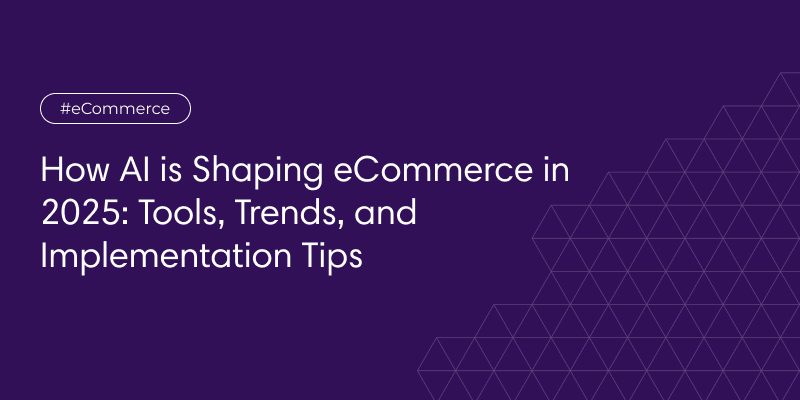1. The Role of AI in Modern eCommerce
Artificial intelligence in eCommerce is centered around data—how it’s collected, interpreted, and used. AI allows for personalization at scale, real-time customer support, smart logistics, predictive analytics, and more. eCommerce platforms are now leveraging AI to power decisions that once took hours of manual input. Machine learning (ML), natural language processing (NLP), and computer vision are key technologies driving these capabilities.
1.1 Evolution of AI in Retail
From simple rule-based product recommendations in the early 2010s to sophisticated AI models in 2025 that predict user behavior and auto-generate marketing content, the retail industry has come a long way. AI adoption accelerated post-pandemic as consumer expectations for personalized and responsive experiences grew rapidly. Now, AI is being embedded in nearly every layer of eCommerce infrastructure.
1.2 Benefits of AI in eCommerce
- Improved customer satisfaction through tailored interactions
- Increased conversion rates and average order value (AOV)
- Reduced operational costs through automation
- Faster and more accurate decision-making
- Efficient inventory and supply chain management
2. AI-Powered Personalization
One of the most visible impacts of AI in eCommerce is personalization. By analyzing user behavior, purchase history, and browsing patterns, AI systems can deliver personalized product recommendations, offers, and content. In 2025, personalization extends beyond on-site experiences—it includes emails, push notifications, voice interactions, and even packaging.
2.1 Real-Time User Segmentation
Modern AI tools like Dynamic Yield and Bloomreach create real-time user segments that adjust based on behavior, location, weather, and more. These segments are used to deliver hyper-relevant content and product offers.
2.2 Predictive Recommendations
Instead of reactive suggestions, AI now predicts what a user may want based on micro-interactions (e.g., hover time, scroll depth). Predictive engines like Amazon Personalize have raised the bar in this domain.
3. Conversational AI and Chatbots
AI-powered chatbots have become a cornerstone of customer service. In 2025, these bots are capable of complex tasks: answering questions, guiding users through checkout, offering discounts, and even processing returns.
3.1 NLP Enhancements
Natural language processing improvements have made bots more human-like. Solutions like LivePerson and Drift now detect emotion and intent to adjust responses dynamically.
3.2 Multilingual and Multichannel Support
Chatbots now support dozens of languages and operate across web, mobile, WhatsApp, and even voice assistants, ensuring 24/7 service across borders.
4. Visual AI and Product Discovery
Visual AI allows users to search for products using images instead of text. Platforms like Syte and Google Lens enable shoppers to upload or scan a picture and receive similar product results. This is revolutionizing search in industries like fashion, home décor, and electronics.
4.1 Augmented Reality (AR) Integration
Many brands now combine AI with AR to let customers visualize products in their environment. IKEA Place and Sephora Virtual Artist are leading examples of this trend.
5. Smart Inventory and Supply Chain Management
AI enhances backend operations by predicting demand, automating procurement, and optimizing delivery routes. This reduces waste, improves fulfillment rates, and cuts shipping costs.
5.1 Predictive Analytics
AI systems forecast trends by analyzing past purchases, promotions, seasonality, and social media signals. This allows businesses to prepare inventory in advance and reduce stockouts.
5.2 Warehouse Robotics
Many fulfillment centers now use AI-guided robots for picking and sorting, reducing human error and increasing throughput.
6. AI in Fraud Detection and Cybersecurity
Cyber threats in eCommerce are more sophisticated than ever. AI solutions monitor transactions for unusual activity, flagging potential fraud before damage is done. Tools like Signifyd use AI to prevent chargebacks and account takeovers in real-time.
6.1 Behavioral Biometrics
AI detects fraudulent behavior by analyzing how users type, swipe, or interact with elements, helping secure accounts even if credentials are compromised.
7. Marketing Automation and Campaign Optimization
AI is transforming marketing—from automated copywriting to real-time bidding on ad platforms. eCommerce marketers now rely on AI to build, test, and optimize campaigns at scale.
7.1 AI Copywriting and Content Generation
Tools like Jasper and Copy.ai generate headlines, product descriptions, and ad copy tailored to audience segments using AI-generated data.
7.2 Campaign Optimization
AI automatically adjusts bids, budgets, and creatives based on performance signals. Google’s Performance Max and Meta’s Advantage+ campaigns are based on AI learning models that improve over time.
8. Voice Commerce and Shopping Assistants
Voice commerce is gaining traction with smart devices. Shoppers use AI assistants to reorder essentials, get product recommendations, or track packages using voice commands.
8.1 Conversational Commerce Platforms
Startups like Jetson and Narvar are helping brands integrate voice and text shopping experiences into their sites and apps, reducing friction and improving accessibility.
9. Implementation Best Practices
- Start with one use case – Pick a narrow AI function such as product recommendations or chatbot support to build familiarity.
- Integrate with analytics – Connect AI tools with your reporting dashboards to track effectiveness.
- Train your data – The better your data, the smarter the AI. Invest in clean, labeled, and diverse datasets.
- Ensure compliance – AI must operate under GDPR, CCPA, and other regulations to protect user privacy.
10. Future Trends in AI for eCommerce
- Generative AI for product imagery – Create dynamic visuals without photoshoots.
- Emotion AI – Analyze customer sentiment in real-time and adapt UX accordingly.
- Fully autonomous customer journeys – From discovery to delivery, AI handles the entire shopping experience.
Conclusion
AI is revolutionizing eCommerce in every dimension—from user experience and logistics to marketing and security. As we move further into 2025, businesses that embrace AI thoughtfully will unlock new opportunities for growth, efficiency, and customer satisfaction. The key lies in strategic implementation, continuous optimization, and a customer-first mindset.
Whether you’re a small brand or an enterprise, AI should be at the core of your eCommerce evolution. The future is intelligent—and it’s already here.

Ecommerce Root is one of the leading ecommerce guide which provides total solutions for ecommerce.









Leave a Reply